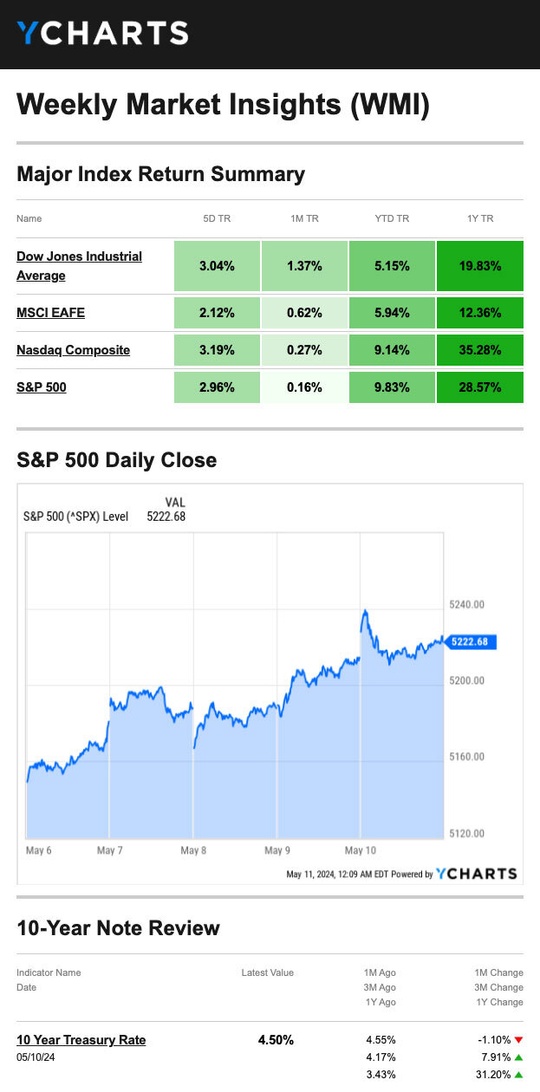Stocks notched a solid gain last week as rate-cut expectations paced the rally as the Q1 earnings season wound down.
Stocks Climb Steadily
Monday opened with stocks picking up where they left off the prior Friday. Stocks were still basking in the afterglow of fresh jobs data, which eased investor concerns of an overheating economy. That and reports of a possible Middle East ceasefire fueled Monday’s rally.1
Stocks hung out in a narrow trading band Tuesday and Wednesday, yawning at the sparse economic news and a handful of negative earnings results. By contrast, the Nasdaq edged lower over those two days.2,3
On Thursday, the S&P 500 closed above 5,200 for the first time since early April. The next day, stocks rallied, and the Dow clinched its eighth consecutive day of gains, the longest winning streak since December and its best weekly performance this year. Fresh data showed consumers continue to have inflation concerns for the year ahead, which was unsettling.4,5


Source: YCharts.com, May 11, 2024. Weekly performance is measured from Monday, May 6, to Friday, May 10.
ROC 5 = the rate of change in the index for the previous 5 trading days.
TR = total return for the index, which includes any dividends as well as any other cash distributions during the period.
Treasury note yield is expressed in basis points.
Jobs Market Shows a “Goldilocks” Outlook
Jobs data from the past few months have shown unemployment levels remain low while job growth stays strong—but not too hot.
And last week’s Conference Board’s employment trends index for April projected slower jobs growth in the second half. The markets all year have responded well when the “Goldilocks” outlook suggests that economic indicators are “just right.”6
This Week: Key Economic Data
Monday: Fed Official Loretta Mester Speech.
Tuesday: Producer Price Index. NFIB Small Business Optimism Index.
Wednesday: Consumer Price Index. Retail Sales. Business Inventories. Fed Official Neel Kashkari Speech.
Thursday: Housing Starts. Jobless Claims. Industrial Production. Import & Export Prices. Fed Official Speeches: Patrick Harker, Raphael Bostic.
Friday: Leading Indicators.
Source: Investors Business Daily – Econoday economic calendar; May 10, 2024
The Econoday economic calendar lists upcoming U.S. economic data releases (including key economic indicators), Federal Reserve policy meetings, and speaking engagements of Federal Reserve officials. The content is developed from sources believed to be providing accurate information. The forecasts or forward-looking statements are based on assumptions and may not materialize. The forecasts also are subject to revision.
This Week: Companies Reporting Earnings
Tuesday: The Home Depot, Inc. (HD)
Wednesday: Cisco Systems, Inc. (CSCO)
Thursday: Walmart Inc. (WMT), Applied Materials, Inc. (AMAT), Deere & Company (DE)
Source: Zacks, May 10, 2024
Companies mentioned are for informational purposes only. It should not be considered a solicitation for the purchase or sale of the securities. Investing involves risks, and investment decisions should be based on your own goals, time horizon, and tolerance for risk. The return and principal value of investments will fluctuate as market conditions change. When sold, investments may be worth more or less than their original cost. Companies may reschedule when they report earnings without notice.

“The secret of happiness isn’t found in seeking more, but in developing the capacity to enjoy less.” –Socrates

Are Social Security Benefits Taxable?
If you receive Social Security benefits, you may have to pay federal income tax on some of these benefits. Your payment will depend on your specific income and filing status.
To find out whether your Social Security benefits are taxable, if you are single, take half of the Social Security money you received throughout the year and add it to your other income, including pensions, wages, interest, dividends, and capital gains. If the total for an individual exceeds $25,000, part of your benefits may be taxable.
If you are married filing jointly, take half of the Social Security money you received throughout the year plus half of your spouse’s Social Security benefits; add both amounts to your combined household income. If the total is over $32,000, part of your benefits may be taxable.
The IRS’s website delineates the taxable percentage of benefits based on the above calculation. These percentages vary between 50% to 85% and depend on your filing status and income levels. For example, if you are filing as a single person with $25,000 to $34,000 income, 50% of your Social Security benefits may be taxable.
The Interactive Tax Assistant on IRS.gov can help you determine whether your Social Security benefits are taxable and, if so, by how much.
*This information is not intended to be a substitute for specific, individualized tax advice. We suggest that you discuss your specific tax issues with a qualified tax professional.
Tip adapted from IRS.gov7

4 Benefits of Yoga
In addition to helping you finally touch your toes, yoga may confer many other benefits, from helping you relax to even potentially helping your heart health. Below are some other potential benefits of yoga:
- Yoga can decrease stress and promote relaxation. Becoming more in tune with your body and where you hold stress is rewarding.
- Yoga may also be able to relieve anxiety. In one study, 34 women diagnosed with an anxiety disorder participated in yoga classes twice weekly for two months. At the end of the study, those who had practiced yoga had significantly lower levels of anxiety than the control group.
- Yoga may help improve heart health and reduce several risk factors for heart disease. One study found that participants over 40 who practiced yoga for five years had lower blood pressure and pulse rates than those who did not.
- Lastly, yoga may help fight depression; this may be because yoga can decrease cortisol levels, a stress hormone that influences serotonin levels, the neurotransmitter frequently associated with depression.


Doi Inthanon, Chom Thong District, Chiang Mai Province
Footnotes and Sources
1.The Wall Street Journal, May 10, 2024
2.The Wall Street Journal, May 7, 2024
3.The Wall Street Journal, May 8, 2024
4.CNBC.com, May 9, 2024
5.The Wall Street Journal, May 10, 2024
6.The Wall Street Journal, May 10, 2024
7. IRS.gov, December 5, 2023
8.Healthline, January 24, 2023
Investing involves risks, and investment decisions should be based on your own goals, time horizon, and tolerance for risk. The return and principal value of investments will fluctuate as market conditions change. When sold, investments may be worth more or less than their original cost.
The forecasts or forward-looking statements are based on assumptions, may not materialize, and are subject to revision without notice.
The market indexes discussed are unmanaged, and generally, considered representative of their respective markets. Index performance is not indicative of the past performance of a particular investment. Indexes do not incur management fees, costs, and expenses. Individuals cannot directly invest in unmanaged indexes. Past performance does not guarantee future results.
The Dow Jones Industrial Average is an unmanaged index that is generally considered representative of large-capitalization companies on the U.S. stock market. Nasdaq Composite is an index of the common stocks and similar securities listed on the NASDAQ stock market and is considered a broad indicator of the performance of technology and growth companies. The MSCI EAFE Index was created by Morgan Stanley Capital International (MSCI) and serves as a benchmark of the performance of major international equity markets, as represented by 21 major MSCI indexes from Europe, Australia, and Southeast Asia. The S&P 500 Composite Index is an unmanaged group of securities that are considered to be representative of the stock market in general.
U.S. Treasury Notes are guaranteed by the federal government as to the timely payment of principal and interest. However, if you sell a Treasury Note prior to maturity, it may be worth more or less than the original price paid. Fixed income investments are subject to various risks including changes in interest rates, credit quality, inflation risk, market valuations, prepayments, corporate events, tax ramifications and other factors.
International investments carry additional risks, which include differences in financial reporting standards, currency exchange rates, political risks unique to a specific country, foreign taxes and regulations, and the potential for illiquid markets. These factors may result in greater share price volatility.
Please consult your financial professional for additional information.
This content is developed from sources believed to be providing accurate information. The information in this material is not intended as tax or legal advice. Please consult legal or tax professionals for specific information regarding your individual situation. This material was developed and produced by FMG Suite to provide information on a topic that may be of interest. FMG is not affiliated with the named representative, financial professional, Registered Investment Advisor, Broker-Dealer, nor state- or SEC-registered investment advisory firm. The opinions expressed and material provided are for general information, and they should not be considered a solicitation for the purchase or sale of any security.
Copyright 2024 FMG Suite.